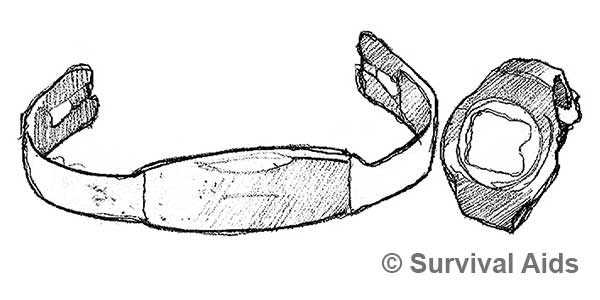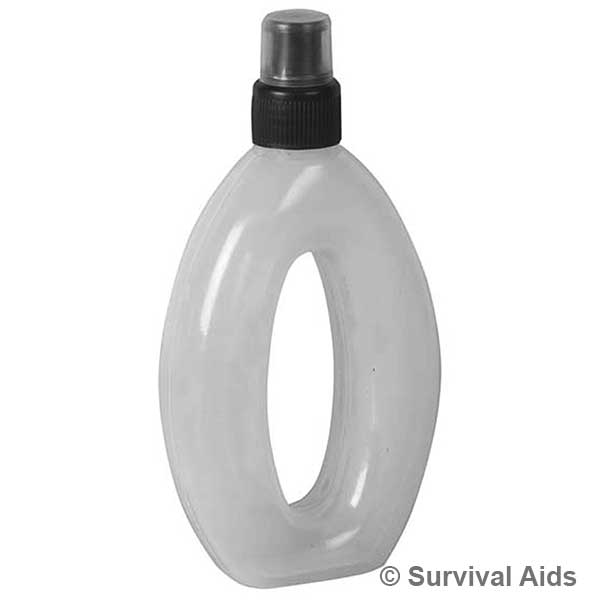Physical Training
BEFORE YOU START TRAINING
Before starting any training or new programme it’s vital that you ensure that you are relatively healthy and don’t have any underlying medical conditions, especially if starting a new programme or returning to training after injury or long absence. Seek advice from a fitness professional, PTI or your GP and plan your training to maximise the training effect. Get yourself checked out.
START OFF EASY
If you are starting training again after a slack period, don’t overdo it, and go off like a greyhound, you won’t be as fit as you used to be FACT. You’ll probably injure yourself, and if after your first run out you're absolutely “hanging out” and not feel good, you’ll find an excuse not to go out again, go easy on yourself initially and then ramp it up when you’re mind and body are back in the habit.
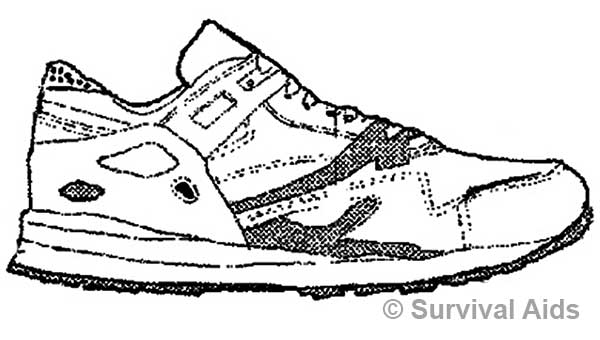
Training Shoes
INTRODUCTION
Soldiering puts a huge strain on our bodies, we all love charging around without a thought for the future when we’re young, but there is a price to pay later in life. The older you get the stiffer, more brittle you become. The truth of it is that we collect injuries in our army life that won't leave us, but we can manage them, and now is the time to start putting the time in. It’s boring but important.
It’s important that we don’t leave it to the 11th hour to stay supple and flexible, little and often is the answer, make sure you stretch out properly after training, it can be boring, but it should be just as much a part of our Training regime as circuits, spinning or weights. if it isn’t currently in your regime then get it in there sharpish. Just because the old and bold are all crippled, doesn’t mean you have to be. They didn’t know what we do today, so there’s no excuse.
Physical training makes up a large part of a soldiers life, it’s really good for you, physically and mentally, it releases endorphins and it’s mostly free. A plan with few drawbacks. In this chapter, we will take a fresh look at how we train, and explore ideas on how we can refresh old techniques and mix it up a bit.
We are creatures of habit, and like routine and some people stick to the same routine because it’s all they know.
Our bodies get bored of routines, as they get used to the same kind of work each day, to keep our bodies alert and motivated we must swap our routines, think up fun new training to do, a new route on the bike. a spinning class, taking up triathlon, you’re only limited by your own imagination. The internet is a great place to look for ideas, there are plenty of magazines on the shelves too, your PTI is a great resource so get over and ask him/her for advice.
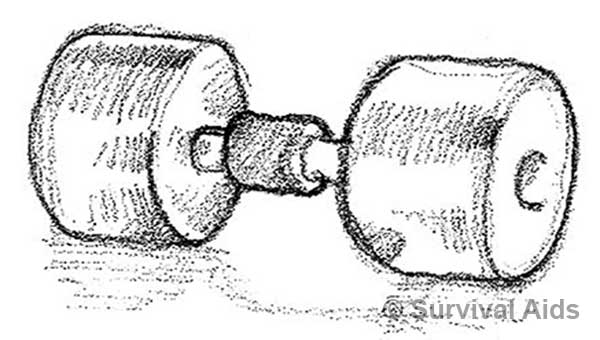
Dumbbells
FITNESS WINS
Running on a track, in the gym, with the dog is all good stuff and will keep you ticking over, but when you add BA, radios, water, weapons, ladders heat and fear, that’s when you realise how fit you have to be for your op. tour. If you think you’re “fit enough” think again, put down that beer, get an early night and smash out another training session before work.
PERIODISATION
When planning your programme bear in mind the four main components of physical fitness. Be honest and realistic about it, you can always ramp it up if you feel like you are idling along after a week or two. Take it steady at first don’t go hurtling headlong into injury. However, none of the components can be neglected! This is known as periodization of training. The length and focus of each period depends on what you are trying to achieve during that period.
Many athletes work on between 4 - 6 week cycles of training with specific focus during that period. You can treat these like modules and its a great aid to motivation, you’re not just training on and on until the end of the world, you’re training in 4-6 week blocks, and can reward yourself at the end of each block, this is an ideal time too to check your PB be it your 10K time, 600 metre swim, press-ups or heaves.
The weeks can then be broken down further into Moderate, Development and Recovery weeks, these weeks are then further broken down into days with a specific focus on each day.
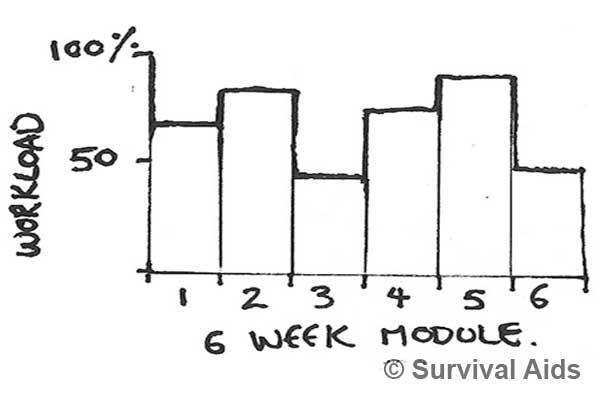
6 Week Target Training
Each day must be used efficiently, for example, is there a benefit going to be gained if the same session is repeated morning and evening for three days in a row? Probably not!
To achieve maximum gains in the time that one has available one has to train hard, but also has to train smart. Hence the importance of spending some time with a PTI or physiologist planning training, rather than training for the sake of training.
This section will provide you with a few examples of training programmes that may help in achieving your goals. However, they are not the be all and end all and should be tailored to suit individual needs.
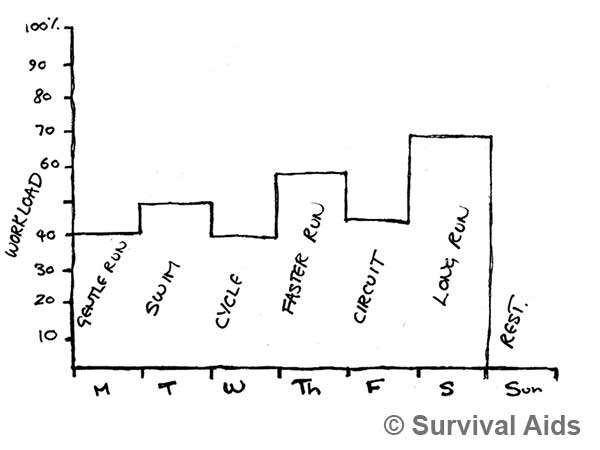
Physical Training
COMPONENTS OF FITNESS
Footballer are fit for football, cyclists are fit for cycling, soldiers, on the other hand, need to be capable of doing many more things, for example carrying an injured colleague to safety, tabbing with heavyweights in your bergen, sprinting for cover, or in the assault with heavy patrol kit, and also just getting up and down from the prone or kneeling position with belt kit, body armour and weapon.
Because of these demands, all four components of fitness must be included in your training programme.
Strength: Strength refers to a muscle’s ability to generate force against physical objects the majority of this training is done using weights. Doing low reps (below 8 reps) 3-5 sets with long recovery (2-4 mins) between sets will build muscle strength
Muscular endurance: Muscular endurance is the ability of a muscle or group of muscles to sustain repeated contractions against a resistance for an extended period of time, tabbing up and down a mountain, hill reps or high reps (above 15) with little rest (30 secs and below).
Aerobic: Running, swimming, cycling, circuits, this can be broken down to a number of levels. Base, threshold sub-maximal
Anaerobic: where the muscles are working without oxygen, to the very maximum, sprints, short duration high intensity
Flexibility: A person’s flexibility refers to the ability of your joints to move through a full range of motion, this is important for injury prevention and functionality of the body, stretching off the muscles you’ve used.
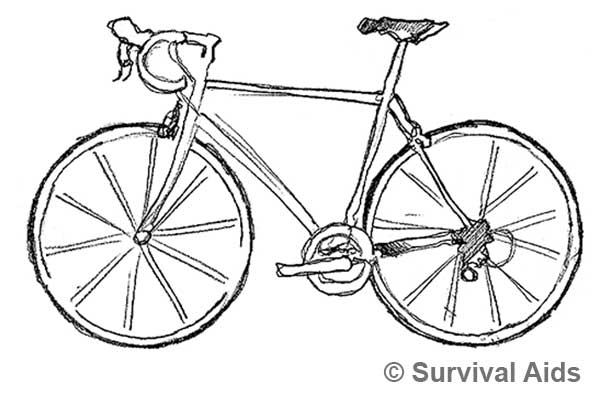
Push Bike
TRAINING INTENSITIES
When most people think of training intensity and heart rates/bpm they think of aerobic (cardiovascular training) and for simplicity, we will stick with that. A heart rate monitor is an easy and accurate way of measuring work intensity, and they are easy to use and affordable. During exercise, there are different intensity/heart rate zones that need to be trained to achieve optimal fitness. The focus on which zone should be prioritised depends on the goals that are trying to be achieved however again ideally none should be entirely neglected.
To achieve accurate heart rate (HR) training zones, physiological testing is necessary however a reasonably accurate guide can be used by using the formula: 220 – your age = max HR (bpm) The majority of HRMs have tests built in to establish your maximum heart rate. Max HR can then be used to calculate the estimated HR for each training zone.
Recovery <= 50% of max HR (able to have a conversation when exercising, can speak a sentence with relative ease)
Low threshold 50-65% of max HR (able to speak short sentences when exercising)
Upper threshold = 65 -80% of max HR (able to speak a few words but towards the top end of this zone not comfortable speaking)
Anaerobic threshold = 80 -100% of max. HR (unable to speak)
Heart Rate Monitor
CIRCUIT TRAINING
You don’t need a lot to set up a circuit, as an example of a basic circuit, split the exercises down into LEGS (squats, burpees, hops, lunges, skipping, sprints), ARMS (press ups, wide, narrow, normal, weights, pull ups, dips) STOMACH (sit ups, plank, crunches, leg raises), and do each one in turn.
Set it out so you have 9 stations, either in a line or in a circle, cones are cheap to buy, or use kit bags, sweat shirts etc... Time it by getting one of the guys to do a few laps of the circle, or running to a tree, then when he drops back in, he shouts “change” and the next guys up and running. Do three sets each with a 2 min. rest in the middle of each then next week do four, and so on...
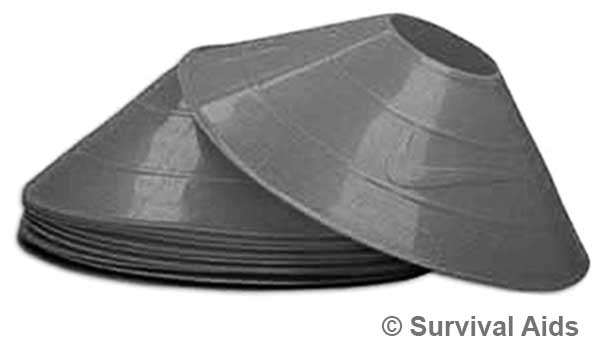
Training Cones
SETTING GOALS
Around the world yachtsman wouldn’t just set off from port and follow his nose or the wind, he meticulously plans his route, timings, tests his kit, makes sure he’s got spares, practices until he’s ready and embarks with purpose.
You need to decide what you want to achieve before you start, this could be weight loss, a period of maintenance training or training for an Ironman or a physically demanding course. Without having a specific aim its hard to tailor training to ensure that the goal is reached and it’s much easier to become distracted and drop off the training, it is a really good aid to motivation, especially when its pouring down with rain and your hungover.
AIDS TO MOTIVATION, STAYING ON TRACK HABIT FORMING
It is believed that it’s easy to fall into bad habits, and hard to fall into good ones, if you can exercise each day 25-30 times then you’re well on your way to embedding the good habit.
EXCUSES, EXCUSES
We can think of a dozen excuses off the top of our heads, focus on the benefits of getting out there and exercising, make exercise a priority, set it in stone, put it in your diary, ring fence it, the tiredness you feel at the end of the working day is most likely mental tiredness, not the physical tiredness which is persuading us that the sofa is better than the track/gym.
To counter this, get the blood flowing by doing some gentle stretches, walking around the block, then you’ll have regained your get up and go.
I used to find that if I was able to get home and instantly undress and get into my kit that would be enough to get me going, don’t open the post or check your messages, or get distracted, get on it.
But if all your attempts at motivating yourself to do physical activity at a certain time are failing then you can always try it at another time of the day, maybe you’re a morning person.
MOTIVATION MAGNETS
Create a picture in your head of where you’d like to be, on the podium clutching gold, or wearing that coveted beret, or para wings.
Before a training session you’re not usually enamoured with the prospect, but afterwards you’ll have the satisfaction of knowing that you did a good job, and that you’re another step nearer to the goal.
One of your goals might be a personal best on the rower, or on a run, why not build this into your 4 week or 6 week plan. On your hard days mount an attack on your pb, keep a log of your times and also what you eat before hand. Keeping a Training diary is a great idea, it will help to motivate you, you’ll be able to see on paper what you ate and how it affected your performance, keep it accurate, discover what food works best for you.
There is a saying in diving, “plan the dive, then dive the plan”, diving is a sport that is full of potential hazards so every phase has to be planned and followed to the letter, having the same approach to your Training plan and sticking to it will ensure that you get great results.
THERAPISTS
Deciding who is the best person to go and see about a specific problem that occurs during training or during day-to-day life can be a daunting decision, whoever you go and see should help, however there may be a better person to go and see for a specific injury. Hopefully this section will provide a brief out line of which therapist to go and see when.
Sports Massage: Increases range of movement, improves flexibility and relieves muscle soreness. It assists in injury prevention and promotes faster recovery from both training and injury. Many people find stretching boring and neglect it, a series of visits to a good masseur can help you keep on top of your flexibility.
Physiotherapy: Deals with human function and movement and aims to maximise its potential. It uses physical techniques to promote, maintain and restore physical, psychological and social well-being. An example might be ankle sprains, muscle tears.
Chiropractic: Focuses around the nervous system based on the understanding that the nervous system coordinates all of the body’s functions. Chiropractics use manipulation and adjustment of body structures (such as the spinal column) so that pressure on nerves may be relieved. Back pain, neck pain, sciatica and general well being.
Osteopathy: Bases its treatment on the principle that the body acts as a whole; when one part of the body is ‘out of position’ it not only affect that specific region, but also the rest of the body. The techniques can be most easily described as being a combination of all of the above.
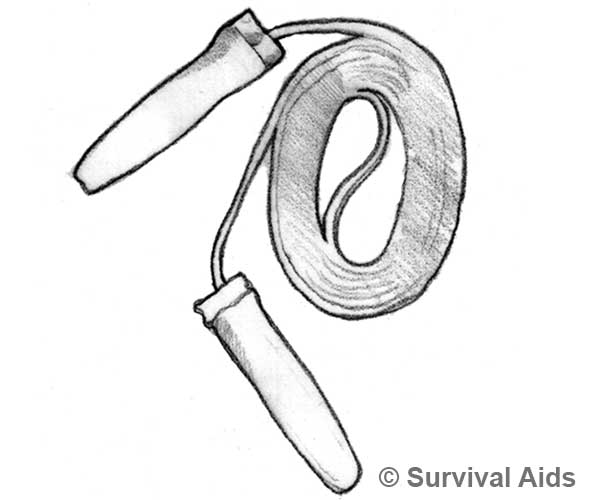
Skipping Rope
INJURY PREVENTION
Injuries are changes within the body that prevent you from performing specific movements/tasks that can usually be achieved. How does one reduce the chance of sustaining an injury? Wrap oneself in cotton wool and never step outside ones comfort zones? That’s not going to happen. Preparation at a number of levels is a very good starting point. Firstly and most basically, make sure if equipment is being used, it is suitable for the job, it fits and you’re accustomed to it.
Train/prepare for the event, if a marathon runner (incredibly fit at what he does) was to play a game of football or lift very heavy weights in the gym, the chance of injury is far higher than with someone who is accustomed to playing football or lifting in the gym!
NUTRITION
The body’s functions are effectively a huge number of chemical reactions occurring very quickly and repeatedly. If the substances that are required for those reactions to occur are limited in quantity, or not present it makes the bodies ability to perform more difficult. Puts stress on systems elsewhere in the body, therefore they will not function as well as they should (dehydration is a very simple and common example of this).
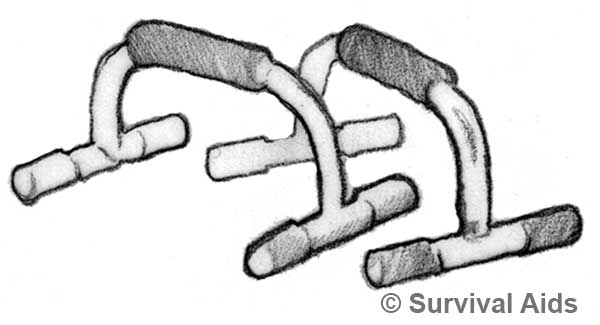
Press Up Bars
A balanced diet tailored to your training requirements alongside determination, a well thought out training plan are all the tools for success. At the end of the day we all know what’s good and what’s bad for us and that it effects performance, you get out what you put in, you are what you eat.
WARMING UP
Do not try and perform high intensity exercise without warming core body temperature up along with the specific movements that are going to be performed. Not doing this will significantly increase the chance of injury, which can be costly in time and money, so schedule it in.
WARMING DOWN
When one exercises there are by-products left within the muscles and the blood. These over time will be transported out of the muscles and blood to areas and organs where they can be broken down allowing the body to recover. However the time that this recovery takes can be greatly reduced by performing a warm down. The warm down can consist of nothing more complex than what you’ve just been doing at a low rate, for example the last 5 mins after your main exercise period briskly walk and stretch.
STRETCHING
It increases flexibility and joint range of motion, improves circulation (again aiding in the movement of waste by-products), improves posture and enhances coordination. That is a lot of benefit for something that’s pretty simple to do and doesn’t require a lot of effort.
It wont have many outward signs, like big arms for the beach, but its a behind the scenes essential for making sure we can keep on doing what we love doing which is getting out and about well into old age. If the bodies joint and muscles are not able to move in the way they are designed, the stresses and strains put on them and surrounding structures will be increased dramatically.
In a nutshell, by not stretching you prevent the body from moving the way it is supposed to, this can lead to increased wear and tear and can lead to injury, so by putting in effort now “little and often” you can avoid lengthy periods out with significant injury.
PREHAB RATHER THAN REHAB
REST
If muscles are totally fatigued, they will not be able to function at required speed and with the appropriate force, again potentially loading joints and other soft tissue structures. Rest can refer to having a rest day each week as part of your prog, or resting between reps in the gym/interval training to having an easy few weeks after large event or at the end of a season for example.
It also includes sleep, this is a crucial part of training allowing the body (and mind) to recover and be ready to train the remaining sessions within that training phase.
Add variety to your Training, and a bit of fun, why not take it in turns with your mates to arrange interesting new circuits, throw in surprises and funnies to spice it up a bit, there are plenty of ideas so get out there, on the internet and in specialist magazines like “Ultra Fit”. It’s always a good idea to run it past your Bn PTI, they can offer advice and will help you run it safely.
Buy yourself a new set of trainers, trainers are for Training, don’t wear them down town, for the weekend or taking the dog for a walk, if you are training 4 or 5 times a week you should be changing your trainers every 6 months, if you’re nailing the mileage and running a lot then a new pair every 500 miles is a good idea. And keep an old set for mooching round the house.
TRAINING PROGRAMMES
So enough talk (or read) it’s time to pull on your trainers, get hold of a training partner to join you, and get out there and “go for it”, make it happen, a journey of 1,000 miles starts with that first step out of the door.
On the following few pages you will find three 3 week training programmes, they are headed Basic, Medium and Higher, and they get progressively more intense.
Each consists of Easy, Moderate and Development Weeks. You can chop and change them to suit your needs. They act as an initial frame work onto which you can build your own programme, but they’re a good place to start.
Remember to take care out there on the roads and paths. In an ideal world we would train in a park, or on common land, but many of us train on roads. Cars, motors bikes and cyclists might not see you as they tear along, so wear something high-visibility, at night carry a little torch, you can get little flashing lights that clip onto the back of your shorts, light yourself up, be seen. Running on grass is much easier on your body than running on tarmac, so hop onto the grass as often as you can, but watch your step.




